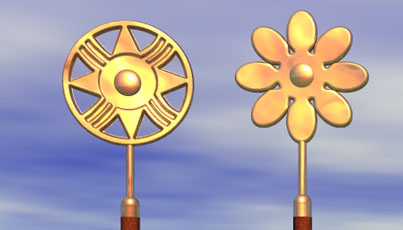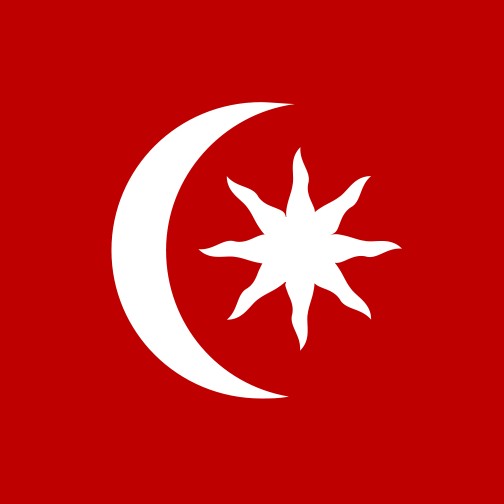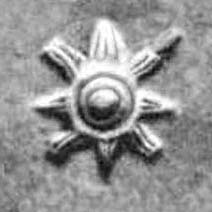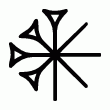The Sun and the Rosette

The Symbolic Marriage of Adam and Eve
I have
been working on this site for a number of years and have wondered on
and off, where in all of this was Adam represented? The concept of
where Adam was located in Sumerian symbolism starts with the Din.Gir.
It is the symbol above the Tree of Life and is my starting point. When
I first
started looking into the symbolism of the winged disk and others I
noticed how in
some cases I was unsure as to whether it was the symbol of the disk or
of Utu/Shamash the sun god. Both the disk and the sun god had
become
an
eight rayed symbol. That is four rectangular panels and four pyramid
shapes. Then on one of the Inanna web sites it was stated
that
the dual nature of Inanna was explained that the star, an eight rayed
star, represented Venus as the morning and evening star which Inanna
as Venus eventually became. Now I was looking at an eight
spoked icon
that represented the winged disk, a star, the sun and the rosette. Then
I
realized that the symbol of the Din.Gir that hovered above the Tree of
Life
linked both Inanna (Eve) and Utu (Adam). Adam became represented by the
sun
god and Eve by the rosette. It was an
epiphany if you will. Here Adam had been hiding in plain sight. In some
representations of the rosette there is a dark circle credited as a
seed. There is also a circle in the center of the symbol for Utu which
looks like a hub. This feature with the eight rays are very similar to
the Sumerian Din.Gir also with a central hub. As to Inanna being
represented by a star so is the sun. In
the cresent and the star motif of the Turkish flag the star is
the sun (my interpretation based on the Neolithic worship of the sun
and moon). "The crescent moon and
star supposed to be holy symbols for pre-Islamic
Turkish tribes while red is the cardinal colour for west [citation
needed]. Gokturks, pre-Islamic Turkic people who lived in Central Asia,
used crescent and star on their coins." (http://en.wikipedia.org/wiki/Flag_of_Turkey)

 The
flag to the far left is from Turkey. The flag next to it is the banner
of Constantinople and adopted by the Ottomans. It displays the star
with the traditional eight rays. The
five-pointed star dates from about 1844. Eventually these two symbols
of the sun and rosette became a
star with a central hub. What you may
not know is that Inanna was the offspring of Nanna, the moon god and
Ningal his wife
(yes, the moon was considered male). Here's the kicker so is Utu.
Inanna and Utu are brother and sister - actually twins within the
Sumerian pantheon. Very surprising
considering Utu is the sun god while Inanna is the Mother Earth
Goddess. In The
Courtship of Inanna and Dumuzi Utu
becomes Inanna's older brother. The link between Inanna and Utu is well
established.
The
flag to the far left is from Turkey. The flag next to it is the banner
of Constantinople and adopted by the Ottomans. It displays the star
with the traditional eight rays. The
five-pointed star dates from about 1844. Eventually these two symbols
of the sun and rosette became a
star with a central hub. What you may
not know is that Inanna was the offspring of Nanna, the moon god and
Ningal his wife
(yes, the moon was considered male). Here's the kicker so is Utu.
Inanna and Utu are brother and sister - actually twins within the
Sumerian pantheon. Very surprising
considering Utu is the sun god while Inanna is the Mother Earth
Goddess. In The
Courtship of Inanna and Dumuzi Utu
becomes Inanna's older brother. The link between Inanna and Utu is well
established.
In
the
famous Code of Hammurabi,
a Babylonian document, it is from Shamash that
Hammurabi gets his inspiration to set down the laws and legal
procedures "according to the just laws of Shamash."
"In terms of character, Utu/Shamash is the Light that All Sees, and thus regarded as a god of truth, justice, and right. Thus his association to law and order, as well as a provider of clarity for oracles. I guess we could very much express the law-giving powers of Utu/Shamash as being the Spirit or Soul of the Law, i.e. He rules over the facts and acts which should guide righteous living, the standards for truthful action and deeds in the world, thus being the god for omens and oracles, because His is also the Will of the Ensouled Universe." (http://www.gatewaystobabylon.com/gods/lords/lordutu.html)
There is one thing that Adam did and Van as well and that was to implement irrigation to grow crops. So lets call Adam Utu and Van Enki. These would be their Sumerian names.
"Enki
then summoned Utu, the Sun God and Light of the Day. Together,
they brought a mist from the depths of the earth and watered the whole
face of the ground. Then Enki and Utu created waterways to surround the
land with a never-ending source of fertile Sweet Waters, and Enki also
devised basins and cisterns to store the waters for further needs. From
these fertile sweet waters flow the four Great Rivers of the Ancient
World, including the Tigris and the Euphrates. Thus, from that moment
on, Dilmun was blessed by Enki with everlasting agricultural and trade
superiority, for through its waterways and quays, fruits and grains
were sold and exchanged by the people of Dilmun and beyond."
Enki
and Ninhursag Sumerian epic
Sound familiar? "But there went up a mist from the earth, and watered the whole face of the ground." (Gen 2:6 KJV) We are talking about the Garden of Eden and therefore Adam and Eve.
It is my opinion that all of the main ancient gods are legendary and are historical personages who have become deified and enlarged over the millennia. I do not believe early man simply "made it up" to explain the natural world. This is not to discount the belief in magic but to augment our understanding of epical events. It is unfortunate that the secular view is considered the only correct view especially when it comes to ancient history. As a footnote of sorts Adam and Eve are not only in the Bible they are also in the Qur'an (Koran) as are allusions to the Tree of Eternity a Forbidden Tree (Tree of Life), the Garden of Eden and Adam made from clay. This history of ancient planetary events predates organized religion and aspects of it can be found in all religions.
Evolution of a Symbol







The very first symbol is from a petroglyph and is usually interpretered as an astral symbol. Even in the Stone Age the central dot or hub is manifested. The next is the solar winged disk also referred to as the Din.Gir. The next image shows this symbol rotated into a symmetrical form. This is where I was confused as to whether it was the Din.Gir or a sun god symbol. At this point I think it is still the Din.Gir. The sun disk of Shamash depicts the Din.Gir as an emblem of the sun god still keeping the "flames" or "flare" and the four panels with its cental hub. The next symbol is Inanna's rosette including the eight rays and the hub. Notice the difference in the leaves and how they match the alternating rays of the sun god emblem. Then the star form appears with the triangular shape from the sun god replacing the leaves of the rosette. Even this star keeps the traditional center hub thereby revealing its ancient roots. It is no wonder that the determinative sign of the dingir is this same eight spoked icon. The larger bottom illustration is another version of the Din.Gir. This eight spoked shape is sometimes referred to as a symbol for Anu from Assyria. It is this compound symbol where the eight spoked cross is directly associated with the Din.Gir. And, of course, it keeps the central hub. It is another example of the cross within a circle.
All of this leads to why this page is subtitled The Marriage of Adam and Eve. Just as there is much symbolism derived from the Tree of Life there is much unrecognized symbolism that stems from the Din.Gir, the seraphic transport by which the Anunnaki "from heaven to earth came." This symbolism is tenacious by any measurment. These traditions die hard if they die at all. The icons for Adam and Eve (a.k.a. Utu and Inanna) derive from a common source that was recognized by the ancients. It was perpetrated through the traditions of early man and documented by the Andites. Thus are the symbols of the sun god and rosette married together through the very ancient symbol of the Din.Gir. Adam and Eve may have defaulted but they are still remembered in the obvious and the hidden. You read it here first.
I find it remarkable that of all the gods of Mesopotamia and related civilizations that Inanna became Astarte, Isis and then Venus. A longevity far outstripping Ninhursag a supposedly higher and more powerful goddess. The sun god came to dominate all the gods. As agriculture became more important the moon god which represented the hunter/gatherers lost influence. But the moon god still held on in importance. The Neolithic stone rings marked both solar and lunar calendars. The Andites as explained elsewhere on this site were the first to become agriculturists and thus sun worshipers. It is the reason why I think the national flag of Turkey is a moon and sun rather than a star. This imagery may pre-date the Andites from Central Asia. Actually there is no definite conclusion on where the crescent and the star came from.


The above images show just how closely related the Moon, Sun and Star symbols are. They are the most prominent with their position at the top of these stele. One definition describing this triad is: "The three powers Sin, Shamash and Ishtar symbolized three great forces of nature: the moon, the sun, and the life-giving force of the earth, respectively." (http://en.wikipedia.org/wiki/Shamash) Here we read that the star represents Ishtar who is Inanna in Sumerian. The "life-giving force of the earth" has more to do with the rosette than a star.


In
the two stele above the king seated to the right is Hammurabi and it
is from Shamash that he receives the code of justice as denoted by the
sun disk symbol above. Both of these  stele
are from Babylon.
The
sun image on the left still keeps the original rectangular panels of
the Din.Gir. (Click on the flag to the left and see how this ancient
symbol is used today. This is perhaps one of the best demonstrations of
the marriage of the sun symbol with its rays and panels and the rosette
as the eight rayed star). Note that the sun
god Shamush is a star with a hub which is the hub so frequently found
on the winged solar disk. So this symbol of the star combines
both Ishtar (Inanna) and Shamash (Utu) the Sumerian twins. Used
independantly the star can
represent the Earth Goddess or the sun god but here the star shape is
clearly the sun.
stele
are from Babylon.
The
sun image on the left still keeps the original rectangular panels of
the Din.Gir. (Click on the flag to the left and see how this ancient
symbol is used today. This is perhaps one of the best demonstrations of
the marriage of the sun symbol with its rays and panels and the rosette
as the eight rayed star). Note that the sun
god Shamush is a star with a hub which is the hub so frequently found
on the winged solar disk. So this symbol of the star combines
both Ishtar (Inanna) and Shamash (Utu) the Sumerian twins. Used
independantly the star can
represent the Earth Goddess or the sun god but here the star shape is
clearly the sun.
 To
the left is a Syrian relief from the 9th century BC. Between the two genii is
shown the symbol of the sun god sitting between the horns of the moon.
This I believe shows the connection between the moon and the sun (the
crescent and the star), a
connection that was very strong during the Neolithic and earlier. I
find it remarkable that the symbols of the rosette and the sun disk
merged into a star and that the star symbol was so closely associated
with the moon who in Sumerian epics was their father. Click on image
for a larger view.
To
the left is a Syrian relief from the 9th century BC. Between the two genii is
shown the symbol of the sun god sitting between the horns of the moon.
This I believe shows the connection between the moon and the sun (the
crescent and the star), a
connection that was very strong during the Neolithic and earlier. I
find it remarkable that the symbols of the rosette and the sun disk
merged into a star and that the star symbol was so closely associated
with the moon who in Sumerian epics was their father. Click on image
for a larger view.
 More on
Sin the Moon God
More on
Sin the Moon God
Sin
is an immigrant god from Saudi Arabia. The name Sin is
Semitic/Akkadian/Babylonian/Assyrian and became equated with Nanna of
the Sumerians. Sin/Syn has had a long history in Saudia Arabia and was
a male god which is just like Nanna the Sumerian moon god. They were
both ancient and very powerful in their sphere of influence. Much has
been written on the lunar based cults of Arabia in which Sin played a
major role. The lunar calender is used today throughout the Muslin
world. The Hajj, a Muslin's pilgrimage to Mecca, follows the
lunar
calender and because of it the Hajj will eventually occur in all
seasons as the lunar year is 354 days.
Easter, like the Hajj, occurs on different dates but within a
much
smaller window. This is because the date for Easter follows both the
lunar and solar calenders. Easter occurs on the first Sunday
following the first full moon after the spring equinox. This is so
Neolithic.
With these solar/lunar calenders one can see by this example
why stone circles were created and how lunar markers and solar markers
were used in conjunction to determine the timing of some religious
feasts and festivals. This is another reason to recognize the emblem of
the crescent and the star as the cresent and the sun. The neutral black
and white illustration is emblematic of Islam. Another fun
fact:
The Queen of Sheba was a moon god worshiper. Sheba is the Hebrew
spelling of Saba located in Yemen. Others say she was a sun worshiper
but I think she was a moon worshiper due to Sin's strong influence in
Saudi Arabia. Her temple just south of
Saba/Sheba is the Bar'an Temple and is in the process of being
excavated.
 Back to Intro
Back to Intro The Anunnaki
The Anunnaki